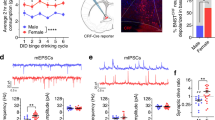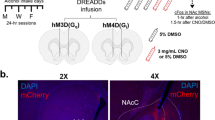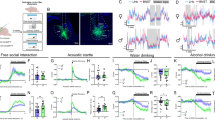Abstract
The serotonin 5HT2c receptor has been widely implicated in the pathophysiology of alcohol use disorder (AUD), particularly alcohol seeking and the affective consequences of chronic alcohol consumption. However, little is known about the brain sites in which 5HT2c exerts its effects on specific alcohol-related behaviors, especially in females. Here, we investigated the effects of site-specific manipulation of the 5HT2c receptor system in the BNST on operant alcohol self-administration behaviors in adult mice of both sexes, including the acquisition and maintenance of fixed-ratio responding, motivation for alcohol (progressive ratio), and quinine-adulterated responding for alcohol on a fixed-ratio schedule (punished alcohol seeking). Knockdown of 5HT2c in the BNST did not affect the acquisition or maintenance of operant alcohol self-administration, nor did it affect progressive ratio responding for alcohol. This manipulation had only a subtle effect on responding for quinine alcohol selectively in females. On the other hand, chemogenetic inhibition of BNST 5HT2c-containing neurons (BNST5HT2c) increased operant alcohol self-administration behavior in both sexes on day 2, but not day 9, of testing. It also increased operant responding for 1000 μM quinine-adulterated alcohol selectively in males. Importantly, chemogenetic inhibition of BNST5HT2c did not alter operant sucrose responding or motivation for sucrose in either sex. We then performed cell-type specific anterograde tracing, which revealed that BNST5HT2c project to similar regions in males and females, many of which have been previously implicated in AUD. We next used chemogenetics and quantification of the immediate early gene cFos to characterize the functional influence of BNST5HT2c inhibition on vlPAG activity. We show that chemogenetic inhibition of BNST5HT2c reduces vlPAG cFos in both sexes, but that this reduction is more robust in males. Together these findings suggest that BNST5HT2c neurons, and to a small extent the BNST 5HT2c receptor, serve to promote aversive responses to alcohol consumption, potentially through sex-dependent disinhibition of vlPAG neurons.
This is a preview of subscription content, access via your institution
Access options
Subscribe to this journal
Receive 13 print issues and online access
$259.00 per year
only $19.92 per issue
Buy this article
- Purchase on Springer Link
- Instant access to full article PDF
Prices may be subject to local taxes which are calculated during checkout





Similar content being viewed by others
References
Schmidt RA, Genois R, Jin J, Vigo D, Rehm J, Rush B. The early impact of COVID-19 on the incidence, prevalence, and severity of alcohol use and other drugs: a systematic review. Drug Alcohol Depend. 2021;228:109065.
Kerr WC, Ye Y, Martinez P, Karriker-Jaffe KJ, Patterson D, Greenfield TK, et al. Longitudinal assessment of drinking changes during the pandemic: the 2021 COVID-19 follow-up study to the 2019 to 2020 National Alcohol Survey. Alcohol Clin Exp Res. 2022;46:1050–61.
Bacqué-Cazenave J, Bharatiya R, Barrière G, Delbecque JP, Bouguiyoud N, Di Giovanni G, et al. Serotonin in animal cognition and behavior. Int J Mol Sci. 2020;21:1649.
Hammack SE, Guo JD, Hazra R, Dabrowska J, Myers KM, Rainnie DG. The response of neurons in the bed nucleus of the stria terminalis to serotonin: implications for anxiety. Prog Neuro-Psychopharmacol Biol Psychiatry. 2009;33:1309–20.
Guo JD, Hammack SE, Hazra R, Levita L, Rainnie DG. Bi-directional modulation of bed nucleus of stria terminalis neurons by 5-HT: molecular expression and functional properties of excitatory 5-HT receptor subtypes. Neuroscience. 2009;164:1776–93.
Hazra R, Guo JD, Dabrowska J, Rainnie DG. Differential distribution of serotonin receptor subtypes in BNST(ALG) neurons: modulation by unpredictable shock stress. Neuroscience. 2012;225:9–21.
Marcinkiewcz CA, Bierlein-De La Rosa G, Dorrier CE, McKnight M, DiBerto JF, Pati D, et al. Sex-dependent modulation of anxiety and fear by 5-HT1A receptors in the bed nucleus of the stria terminalis. ACS Chem Neurosci. 2019;10:3154–66.
Mazzone CM, Pati D, Michaelides M, DiBerto J, Fox JH, Tipton G, et al. Acute engagement of G(q)-mediated signaling in the bed nucleus of the stria terminalis induces anxiety-like behavior. Mol Psychiatry. 2018;23:143–53.
Flanigan ME, Hon OJ, D’Ambrosio S, Boyt KM, Hassanein L, Castle M, et al. Subcortical serotonin 5HT2c receptor-containing neurons sex-specifically regulate binge-like alcohol consumption, social, and arousal behaviors in mice. Nat Commun. 2023;14:1800.
Marcinkiewcz CA, Dorrier CE, Lopez AJ, Kash TL. Ethanol induced adaptations in 5-HT2c receptor signaling in the bed nucleus of the stria terminalis: implications for anxiety during ethanol withdrawal. Neuropharmacology. 2015;89:157–67.
Heisler LK, Zhou L, Bajwa P, Hsu J, Tecott LH. Serotonin 5-HT2C receptors regulate anxiety-like behavior. Genes Brain Behav. 2007;6:491–6.
Berglund ED, Liu C, Sohn JW, Liu T, Kim MH, Lee CE, et al. Serotonin 2C receptors in pro-opiomelanocortin neurons regulate energy and glucose homeostasis. J Clin Investig. 2013;123:5061–70.
Schindelin J, Arganda-Carreras I, Frise E, Kaynig V, Longair M, Pietzsch T, et al. Fiji: an open-source platform for biological-image analysis. Nat Methods. 2012;9:676–82.
Lopez MF, Laber K. Impact of social isolation and enriched environment during adolescence on voluntary ethanol intake and anxiety in C57BL/6J mice. Physiol Behav. 2015;148:151–6.
Sneddon EA, Ramsey OR, Thomas A, Radke AK. Increased responding for alcohol and resistance to aversion in female mice. Alcohol Clin Exp Res. 2020;44:1400–9.
Gianessi CA, Gereau GB, Haun HL, Pati D, Sides T, D’Ambrosio SL, et al. Disentangling the effects of Corticotrophin Releasing Factor and GABA release from the ventral bed nucleus of the stria terminalis on ethanol self-administration in mice. bioRxiv. 2023. 2023.03.02.530838.
Radke AK, Sneddon EA, Frasier RM, Hopf FW. Recent perspectives on sex differences in compulsion-like and binge alcohol drinking. Int J Mol Sci. 2021;22:3788.
Radke AK, Sneddon EA, Monroe SC. Studying sex differences in rodent models of addictive behavior. Curr Protoc. 2021;1:e119.
Sneddon EA, White RD, Radke AK. Sex differences in binge‐like and aversion‐resistant alcohol drinking in C57 BL/6J mice. Alcohol Clin Exp Res. 2019;43:243–9.
Marcinkiewcz CA, Mazzone CM, D’Agostino G, Halladay LR, Hardaway JA, DiBerto JF, et al. Serotonin engages an anxiety and fear-promoting circuit in the extended amygdala. Nature. 2016;537:97–101.
Satpute AB, Wager TD, Cohen-Adad J, Bianciardi M, Choi JK, Buhle JT, et al. Identification of discrete functional subregions of the human periaqueductal gray. Proc Natl Acad Sci. 2013;110:17101–06.
Hao S, Yang H, Wang X, He Y, Xu H, Wu X, et al. The lateral hypothalamic and BNST GABAergic projections to the anterior ventrolateral periaqueductal gray regulate feeding. Cell Rep. 2019;28:616–24.e5.
Verendeev A, Riley AL. The role of the aversive effects of drugs in self-administration: assessing the balance of reward and aversion in drug-taking behavior. Behav Pharmacol. 2013;24:363–74.
Siciliano CA, Noamany H, Chang CJ, Brown AR, Chen X, Leible D, et al. A cortical-brainstem circuit predicts and governs compulsive alcohol drinking. Science. 2019;366:1008–12.
Lopez MF, Doremus-Fitzwater TL, Becker HC. Chronic social isolation and chronic variable stress during early development induce later elevated ethanol intake in adult C57BL/6J mice. Alcohol. 2011;45:355–64.
Rivera-Irizarry JK, Skelly MJ, Pleil KE. Social isolation stress in adolescence, but not adulthood, produces hypersocial behavior in adult male and female C57BL/6J mice. Front Behav Neurosci. 2020;14:129.
Rosinger A, Herrick K, Gahche J, Park S. Sugar-sweetened Beverage Consumption Among U.S. Youth, 2011-2014. NCHS Data Brief. 2017;1–8.
Wakabayashi KT, Greeman EA, Barrett ST, Bevins RA. The sugars in alcohol cocktails matter. ACS Chem Neurosci. 2021;12:3284–7.
Stierman B, Ansai N, Mishra S, Hales CM. Special diets among adults: United States, 2015–2018. US Department of Health and Human Services, Centers for Disease Control and Prevention; 2020.
Simons RM, Hansen JM, Simons JS, Hovrud L, Hahn AM. Drunkorexia: Normative behavior or gateway to alcohol and eating pathology? Addict Behav. 2021;112:106577.
Acknowledgements
Figures for this manuscript were created using BioRender.com. The authors would like to acknowledge Drs. Alison Roland and Brianna George for their assistance editing this manuscript.
Funding
This work was supported by grants from the National Institutes of Health’s (NIH) National Institute of Alcohol Abuse and Alcoholism (NIAAA) (MEF: K99 AA030628-02; TLK: R01 AA019454-12).
Author information
Authors and Affiliations
Contributions
MEF, CG, and TLK conceived of and designed experiments. MEF, CG, MC, WD, and TS performed behavioral experiments. MEF, MC, and TS performed histology. CG and MEF performed intracranial surgeries. MEF analyzed data, and MEF and TLK wrote manuscript with edits from all authors.
Corresponding author
Ethics declarations
Competing interests
The authors declare no competing interests.
Additional information
Publisher’s note Springer Nature remains neutral with regard to jurisdictional claims in published maps and institutional affiliations.
Supplementary information
Rights and permissions
Springer Nature or its licensor (e.g. a society or other partner) holds exclusive rights to this article under a publishing agreement with the author(s) or other rightsholder(s); author self-archiving of the accepted manuscript version of this article is solely governed by the terms of such publishing agreement and applicable law.
About this article
Cite this article
Flanigan, M.E., Gianessi, C., Castle, M. et al. Bed Nucleus of the Stria Terminalis (BNST) neurons containing the serotonin 5HT2c receptor modulate operant alcohol self-administration behavior in mice. Neuropsychopharmacol. 49, 709–719 (2024). https://doi.org/10.1038/s41386-023-01753-7
Received:
Revised:
Accepted:
Published:
Issue Date:
DOI: https://doi.org/10.1038/s41386-023-01753-7



